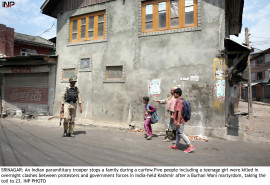
ISLAMABAD: If India unilaterally scraps the Indus Water Treaty, Pakistan, already a water-deficient country, will face a drought-like situation besides experiencing a reduction in hydropower generation, shrinkage of flows in irrigation system, aggravating an already deepening environmental crisis, experts maintained on Wednesday.
Expressing grave concern over the absence of a national strategy to cope with the emerging situation, they were in agreement that the country would be faced with an acute shortage of water simply because there was a shortage of water reservoirs.
An official, who spoke on condition of anonymity, said that the authorities concerned should hammer out plans for such emergencies.
Meanwhile, Pakistan Meteorological Department’s chief Dr Ghulam Rasul said: “The suspension of water supply by India will have an immediate impact on southern Sindh, Balochistan and Punjab mainly because these areas are already facing water shortages because they receive below average rainfall especially during winters.”
He said currently, Pakistan has two main reservoirs, Mangla and Tarbela dams with a maximum storage capacity of 30-day water supply.
After monsoon, he said, some amount of water was already used.
The water storage capacity of these two reservoirs has already dropped to 30 percent mainly because of silting.
In winters, the water inflow in Tarbela Dam is very low.
“In winter, Pakistan needs ample amount of water for sowing Rabi crops and any blockage in water flow will have an adverse impact on winter crop production,” said Dr Rasul.
According to data collected by IRSA, Tarbela Dam’s maximum water storage capacity is 6.2 million acre-foot, while Mangla Dam can hold 7.3 million acre-foot.
However, until Tuesday, Tarbela Dam had 4.4 million acre-foot and Mangala Dam contained 5.4 million acre-foot of water.
Every year, around 145,000 million acre-foot of water enters into Pakistan through rain, snow and glacier melting, out of which 30,000 million acre-foot re-enters the sea because of scarcity of water reservoirs.
Meanwhile, 15 million acre-foot of water is wasted in canals during irrigation.
“Pakistan’s irrigation system is already facing a shortage of 14 million acre-foot of water and if India suspends our water supply … it will badly affect our Rabi crops,” said an official on condition of anonymity.
Published in The Express Tribune, September 29th, 2016.
















































COMMENTS (5)
Comments are moderated and generally will be posted if they are on-topic and not abusive.
For more information, please see our Comments FAQ